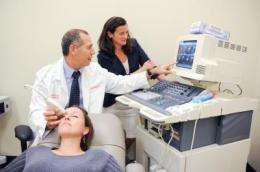Treating disease by the numbers

Mathematical modeling being tested by researchers at the School of Science at Indiana University-Purdue University Indianapolis (IUPUI) and the IU School of Medicine has the potential to impact the knowledge and treatment of several diseases that continue to challenge scientists across the world.
The National Science Foundation recently recognized the work led by Drs. Giovanna Guidoboni, associate professor of mathematics in the School of Science, and Alon Harris, professor of ophthalmology and director of clinical research at the Eugene and Marilyn Glick Eye Institute, for its new approach to understanding what actually causes debilitating diseases like glaucoma. Their research could translate to more efficient treatments for diseases like diabetes and hypertension as well.
Glaucoma is the second-leading cause of blindness in the world, yet the only primary form of treatment is to reduce pressure in the patient's eye. However, as many as one-third of the glaucoma patients have no elevated eye pressure, and the current inability to better understand what risk factors led to the disease can hinder treatment options.
Mathematical modeling, which creates an abstract model using mathematical language to describe the behavior of a system, allows doctors to better measure things like blood flow and oxygen levels in fine detail in the eye, the easiest human organ to study without invasive procedures. Models also can be used to estimate what cannot be measured directly, such as the pressure in the ocular vessels.
Through simulations, the mathematical model can help doctors determine the cause and effect of reduced blood flow, cell death and ocular pressure and how those risk factors affect one another in the presence of glaucoma. A better understanding of these factors—and the ability to accurately measure their interaction—could greatly improve doctors' ability to treat the root causes of disease, Harris said.
"This is a unique, fresh approach to research and treatment," Harris said. "We're talking about the ability to identify tailor-made treatments for individual patients for diseases that are multi-factorial and where it's difficult to isolate the path and physicality of the disease."
Harris and Guidoboni have worked together for the past 18 months on the project. Dr. Julia Arciero, assistant professor of mathematical sciences at IUPUI, is a principle investigator on the project as well with expertise in mathematical modeling of blood flow.
The preliminary findings have been published in the British Journal of Ophthalmology and the research currently is under review in the Journal of Mathematical Biosciences and Engineering and the European Journal of Ophthalmology. The NSF recognized their work on Aug. 30 with a three-year grant to continue their research.
The pair also presented their findings at the 2012 annual meeting of the Association for Research in Vision and Ophthalmology (ARVO). Harris suggested that, out of the 12,000 ARVO participants, their group might have been the only research group to include mathematicians, which speaks highly of the cross-disciplinary collaboration occurring regularly at IUPUI.
"We approached this as a pure math question, where you try to solve a certain problem with the data you have," said Guidoboni, co-director of the School of Science Institute for Mathematical Modeling and Computational Science (iM2CS) at IUPUI, a research center dedicated to using modeling methods to solve problems in medicine, the environment and computer science.
Guidoboni has expertise in applied mathematics. She also has a background in engineering, which she said helps her to approach medical research from a tactical standpoint where the data and feedback determine the model. She previously used modeling to better understand blood flow from the heart.
Harris said the potential impact has created quite a stir in the ocular research community.
"The response among our peers has been unheard of. The scientific community has been accepting of this new method and they are embracing it," Harris added.
The group will seek additional research funding through the National Institute of Health, The Glaucoma Foundation and other medical entities that might benefit from the research. The initial success of their collaboration should lead to more cross-disciplinary projects in the future, Guidoboni said.














